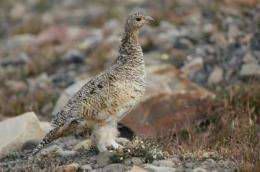The burly bird catches the girl

While the early bird might catch the worm, it's the quick bird that lands the ladies, according to new research into the running performance of an Arctic cousin of the grouse.
Scientists studying rock ptarmigan on the Norwegian archipelago of Svalbard discovered a large difference in the running capabilities between the sexes, with the larger males able to run more efficiently and up to 50% faster than females.
The University of Manchester team suggested that faster, efficient male birds are more successful at breeding, being able to defend larger territories against rivals, indicating that physiology, and not just physical appearance, plays a role in sexual selection.
"Little is known about the role physiology – the internal biological functions of living organisms – plays in sexual selection in birds and other animals," said Dr Jonathan Codd, who led the study in the University's Faculty of Life Sciences.
"Male and female ptarmigan exhibit very distinct behaviours during the breeding season. Throughout the summer months, when there is constant daylight on Svalbard, male ptarmigan have to defend their territory from rival males 24 hours a day and are continually active. This places huge demands on their locomotor system."
"As a result, male ptarmigans have far superior running abilities to females and, despite their larger size, are much more efficient, expending less energy and are able to achieve aerial running – where both feet are off the ground at the same time – which females cannot."

The Manchester team say their findings are important for two reasons. Some bird species, like some other animal species, exhibit obvious physical differences between the sexes. For instance, males, as well as females, can be many times larger than the opposite gender. Despite these differences, scientists have rarely looked at their physiological consequences.
The gender difference among ptarmigans is relatively subtle; males are slightly larger than females and, as with many bird species, their plumage differs. What this research shows is that even animals with physically similar sexes can show major physiological differences, and the researchers suggest that gender inequality should play a more significant role in zoological studies of the animal kingdom in the future.
Secondly, the physical appearance of male and female birds – and other animals – is well documented as playing a role in sexual selection. Male birds are often more colourful than their drab female counterparts and it is known that this plays an important role in the success of males finding mates. This study shows that physiological attributes may also play a role in the breeding success of male birds, with females choosing mates that are faster and able to defend larger territories for longer.
"This research demonstrates that, as well as physical appearance, there may be physiological determinants at play in the sexual selection process, as females appear to be choosing males who successfully defend territories, which is dependent upon their running ability," said co-author Dr Robert Nudds.
"We now plan to look at these differences between the sexes in more detail to better understand what is taking place in the mating behaviour of birds."
More information: The study is published in the journal Proceedings of the Royal Society B today (Wednesday, August 17).
Provided by University of Manchester


















